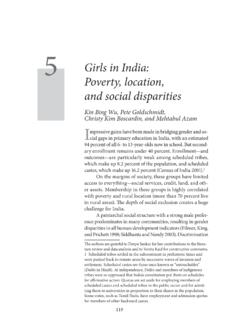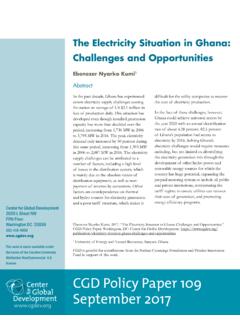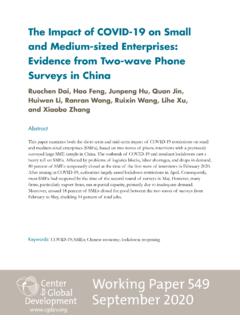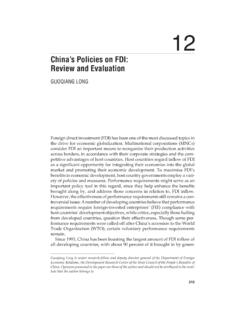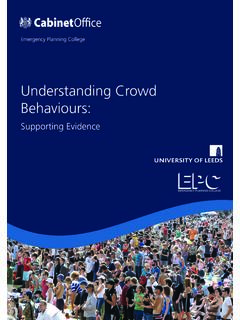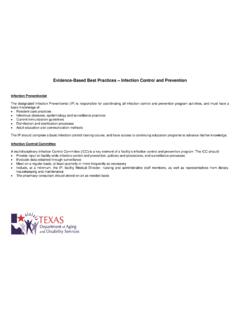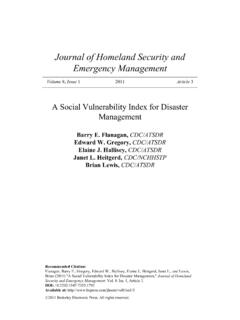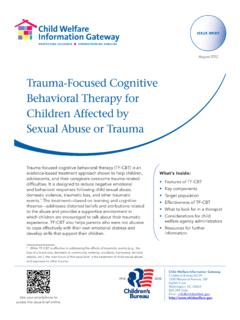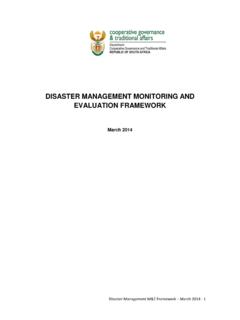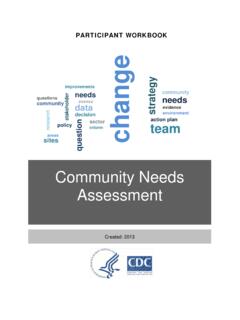Transcription of Planning for School Reopening and Recovery After COVID …
1 Planning for School Reopening and Recovery After COVID -19. An evidence Kit for Policymakers Shelby Carvalho Jack Rossiter Noam Angrist Susannah Hares Rachel Silverman Center for Global Development. 2020. Creative Commons Attribution-NonCommercial Center for Global Development 2055 L Street, NW Fifth Floor Washington, DC 20036. Contents Introduction .. ii 1 Engaging Communities in School Reopening Plans .. 1. 2 Targeting Resources Where They Are Most Needed .. 3. 3 Getting Children Back to School .. 6. 4 Making School Environments Safe .. 9. 5 Recovering Learning Loss .. 12. Technical Appendices.
2 15. Many thanks to Radhika Bhula and John Floretta at J-PAL for contributing to the briefs, and to Laura Moscoviz and Ana Minardi for research assistance. The Center for Global Development is grateful for contributions from the Bill & Melinda Gates Foundation, the Elma Relief Foundation, the UBS Optimus Foundation, and the Vitol Foundation in support of this work. Introduction Most governments around the world have temporarily The briefs are accompanied by CGD's COVID -19 edu- closed schools in an attempt to contain the spread of cation policy tracker, which provides up-to-date the COVID -19 pandemic.
3 Many have launched distance information on each country's policy response and learning programs and are beginning to plan for recov- Reopening plans, as they emerge. ery, a phase that involves much more than Reopening The World Bank, the World Health Organization, the gates and readmitting students. UNESCO, UNICEF, Education International, the Inter- During the response, there may be opportunities for agency Network for Education in Emergencies, and the governments to improve practices and build back World Food Programme have released comprehensive better, but decisions are being made under extreme guidance on education policy responses to COVID -19.
4 Uncertainty. In this context, education policymak- and Planning frameworks for School Reopening . This ing is particularly difficult but will be strongest when evidence kit complements those resources. it is: (1) informed by existing rigorous evidence ;. In areas where the rigorous evidence is thin, we high- (2) approached with a long-term perspective that prior- light this and emphasize the importance of generat- itizes flexibility, communication, and trust; and (3) able ing knowledge during this pandemic to inform policy to be adapted based on new data and information adaptations now and in future crises.
5 Each brief is gained from community engagement and monitoring. complemented by an in-depth technical appendix The short and accessible briefs collected here draw with details on the evidence supporting key findings on rigorous evidence relevant to the COVID -19 emer- and recommendations. gency to formulate recommendations for policymak- There is still a huge amount to learn about the impacts of ers on five critical dimensions of School Reopening and each country's education policy response to COVID -19;. Recovery : it is too early to speculate on the effectiveness of different 1. Engaging communities in Reopening plans choices, or their potential in different contexts.
6 We will be keeping our eye on the evidence as it emerges and, 2. Targeting resources to where they are most in the months ahead, we will release additional analyses needed of the latest evidence on promising practices and pre- 3. Getting children back to School paring for future emergencies. In the meantime, CGD's COVID -19 education policy tracker provides up-to-date 4. Making School environments safe information on each country's policy choices. 5. Recovering learning loss and building back better ii 1. Engaging Communities in School Reopening Plans Successful Reopening and Recovery rely on public trust in the government.
7 Trust can be built and maintained Recommendations by engaging communities in Planning for reopen- ing and by clearly communicating through credible To productively engage communities and channels. build the trust needed to design and imple- ment effective Reopening plans, policymakers Policymakers will want access to evidence that sup- should: ports their Planning and decision making, and to draw on relevant experience from elsewhere. This brief Prioritize community engagement early summarizes available rigorous evidence regarding the to build trust, shape perceptions of risk, engagement of communities in Planning for School and improve responses to government Reopening and identifies two recommended actions policy.
8 For policymakers based on that body of evidence . Share clear, credible, and consistent messaging through multiple channels Summary of evidence to reach all groups and to match local resources and norms. Trust, risk, and community participation A robust body of evidence suggests that establishing public trust, managing fear and perceptions of risk, and leveraging community engagement are key to engaging teachers and teachers' unions, School - effective crisis response. Governments need to decide based management committees and other par- how to engage community members in Reopening ent organizations throughout can increase the plans and implementation; what, when, and how often relevance of plans and compliance with govern- information should be shared with affected commu- ment interventions as schools reopen.
9 Nities; and with whom and through which channels to communicate. Communication strategies There is limited evidence regarding the effectiveness The evidence on building trust with communities of specific communication strategies to support emer- affected by emergencies shows that: gency response. What is known strongly suggests that communication content should be clear and credible, Leveraging community involvement to build and be disseminated in a manner aligned with local trust will play a vital role in facilitating the norms. The best communication channels for reach- Reopening process and in shaping public per- ing households will vary considerably across contexts ceptions of the state over the long term.
10 But, wherever possible, multiple channels should be Effectively responding to health crises requires used to reach all groups. The Signal Code outlined localized efforts to work with communities in the humanitarian and disaster literature argues affected by the crisis. For the education sector, that not only does the public benefit from consistent 1. information about the crisis and Reopening plans, it Many governments have already strengthened has the right to it. radio, television, and mobile communications during the crisis; these same channels could be The evidence on effective communication strategies used to deliver Reopening messages.



